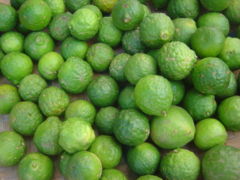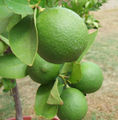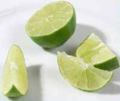Lime
| Lime subsp. var. | ||||||||||||||||||||||||||||||||||||||||||||||||||||||||
|---|---|---|---|---|---|---|---|---|---|---|---|---|---|---|---|---|---|---|---|---|---|---|---|---|---|---|---|---|---|---|---|---|---|---|---|---|---|---|---|---|---|---|---|---|---|---|---|---|---|---|---|---|---|---|---|---|

|
|
| ||||||||||||||||||||||||||||||||||||||||||||||||||||||
| ||||||||||||||||||||||||||||||||||||||||||||||||||||||||
| Lime {{{status}}} Fossil range: {{{fossil_range}}}
| ||||||||||||||||||||||||||||||||||||||||||||||||||||||||||||||||||
|---|---|---|---|---|---|---|---|---|---|---|---|---|---|---|---|---|---|---|---|---|---|---|---|---|---|---|---|---|---|---|---|---|---|---|---|---|---|---|---|---|---|---|---|---|---|---|---|---|---|---|---|---|---|---|---|---|---|---|---|---|---|---|---|---|---|---|
 Kaffir Lime fruit | ||||||||||||||||||||||||||||||||||||||||||||||||||||||||||||||||||
| Plant Info | ||||||||||||||||||||||||||||||||||||||||||||||||||||||||||||||||||
| ||||||||||||||||||||||||||||||||||||||||||||||||||||||||||||||||||
| Scientific classification | ||||||||||||||||||||||||||||||||||||||||||||||||||||||||||||||||||
| ||||||||||||||||||||||||||||||||||||||||||||||||||||||||||||||||||
| [[{{{diversity_link}}}|Diversity]] | ||||||||||||||||||||||||||||||||||||||||||||||||||||||||||||||||||
| {{{diversity}}} | ||||||||||||||||||||||||||||||||||||||||||||||||||||||||||||||||||
| Binomial name | ||||||||||||||||||||||||||||||||||||||||||||||||||||||||||||||||||
| {{{binomial}}} | ||||||||||||||||||||||||||||||||||||||||||||||||||||||||||||||||||
| Trinomial name | ||||||||||||||||||||||||||||||||||||||||||||||||||||||||||||||||||
| {{{trinomial}}} | ||||||||||||||||||||||||||||||||||||||||||||||||||||||||||||||||||
| Type Species | ||||||||||||||||||||||||||||||||||||||||||||||||||||||||||||||||||
| {{{type_species}}} | ||||||||||||||||||||||||||||||||||||||||||||||||||||||||||||||||||
| {{{subdivision_ranks}}} | ||||||||||||||||||||||||||||||||||||||||||||||||||||||||||||||||||
| [[Image:{{{range_map}}}|{{{range_map_width}}}|]] | ||||||||||||||||||||||||||||||||||||||||||||||||||||||||||||||||||
| Synonyms | ||||||||||||||||||||||||||||||||||||||||||||||||||||||||||||||||||
| {{{synonyms}}} |
Template:Nutritionalvalue Lime is a term referring to a number of different citruses, both species and hybrids, which are typically round, green to yellow in color, 3-6 cm in diameter, generally containing sour pulp, and frequently associated with the lemon.
Varieties
The limes most commonly available commercially are the smaller, yellower Key lime (Citrus aurantifolia) and the larger, greener Persian lime (Citrus × latifolia).[1] "Key lime" is an American retronym, as the original fruit known in English as a "lime" was Citrus aurantifolia, derived from the Persian name لیمو, limu (the fruit was introduced to Europe during the Crusades). Other limes include the Mandarin lime (Citrus limonia), Kaffir lime (Citrus hystrix), the various Australian limes, Spanish lime (Melicoccus bijugatus), wild lime (Adelia ricinella), sweet lime (Citrus limetta), Palestine sweet lime (Citrus limettioides), and musk lime (X Citrofortunella mitis).[2] The limequat is a lime-kumquat hybrid.
Uses
Limes in drinks
Lime fruit, and particularly their juice, are used in beverages, such as limeade (akin to lemonade). Alcoholic beverages prepared with limes include cocktails such as gin and tonic, margarita, mojito, and Cuba libre, as well as many drinks that may be garnished with a thin slice of the fruit or corkscrew strip of the peel (twist). One customary consumption of tequila is in shots accompanied by lime wedges and salt. Beer is often served with limes in Mexico, as well as some other countries. Lime juice is also used in commercial soft drinks.
Limes in cooking
In cooking, lime is valued both for the acidity of its juice and the floral aroma of its zest. It is used in tacos, Key lime pie, a traditional Florida dessert, and is a very common ingredient in authentic Mexican and Southwestern American dishes. It is also used for its pickling properties in ceviche. Additionally, the leaves of the Kaffir lime are used in southeast Asian cuisine. The use of dried limes as a flavoring is typical of Persian cuisine and Sprite.
Other uses
In order to prevent scurvy during the 19th century, British sailors were issued a daily allowance of citrus such as lime (presumably Citrus aurantifolia), which led in time to the nickname "limey" for all Britons. It was later discovered that this beneficial effect derived from the quantities of Vitamin C the fruit contains.
Lime extracts and essential oils are frequently used in perfumes, cleaning products, and aromatherapy.
Lime Associations & Organizations
AFABLE (Association For A Better Lime Experience) was founded in 2002. This organization seeks to promote the use of lime in everyday cooking, and believes that lime needs better culinary representation. AFABLE members believe that lime is the most flavorful, delicious citrus.
See also
- Australian limes
- Australian desert lime (Eremocitrus glauca)
- Australian finger lime (Citrus australasica)
- Australian round lime (Citrus australis)
- Blood lime
- Kaffir lime (Citrus hystrix) (a.k.a. kieffer lime; makrut, or magrood)
- Key lime (Citrus aurantifolia) (a.k.a. Mexican, West Indian, or Bartender's lime)
- Lime tree (Tilia sp.) (a.k.a. linden)
- Mandarin lime (Citrus limonia)
- Musk lime (X Citrofortunella mitis)
- Palestine sweet lime (Citrus limettioides)
- Persian lime (Citrus x latifolia) (a.k.a. Tahiti or Bearss lime)
- Spanish lime (Melicoccus bijugatus) (a.k.a. mamoncillo, mamón, ginep, quenepa, or limoncillo)
- Sweet lime (Citrus limetta) (a.k.a. sweet limetta, Mediterranean sweet lemon)
- Wild lime (Adelia ricinella)
- Limequat (lime × kumquat)
Notes
Gallery
-
A cluster of unripened limes on a bush.
-
Lime wedges are typically used in drinks.
-
A closeup of a whole lime.
-
Grocery store limes
References
- Citrus aurantifolia Swingle
- Tahiti Lime
- Citrus (Orange, Lemon, Lime, Grapefruit, Naartjie genus)
- Citrus
- Hort 403 - Lecture32
- Key Limes (Citrus aurantifolia)



